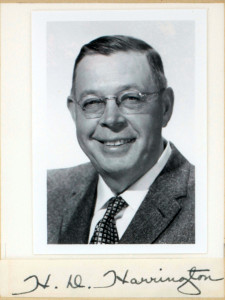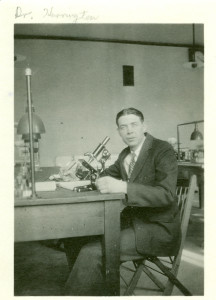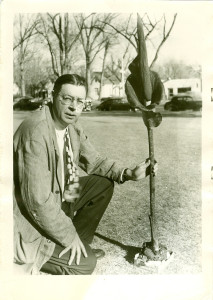by Jennifer Ackerfield
Harold David (H.D.) Harrington developed his deep love of and respect for plants during his childhood on a farm. He was born in De Motte, Indiana, on Mar. 14, 1903, living there until 1909 when the the family moved to Mitchell, South Dakota. They moved yet again in 1911 to Graettinger, Iowa, where Harrington eventually spent the majority of his childhood with his then seven siblings.
Harrington was destined for greater learning, but by the time he was ready to attend college, the country was in the grips of the Great Depression and money was very tight. To cope with the shortage of funds, Harold and his older brother Elbert alternated years in school – one would attend one year while the other worked.
While at school, Harrington taught himself to play the violin and even played at dances to earn extra money. He also played the Spanish guitar and the ukulele, and in later years he would bring musical instruments on collecting trips with students and play around the campfire at night after a long day of botanizing. Harrington also read and wrote poetry and was an avid mystery-story reader.
He completed only two years of college before he was called back to his hometown to teach and coach the football and basketball teams at the high school. He eventually earned his bachelor’s degree in 1927 from the University of Northern Iowa. In 1928, he earned his Master’s degree and in 1933 his PhD, again from the University of Northern Iowa. In 1933, he married Edith Jirsa in Waterloo, Iowa.
Soon after, he was offered a botany position at CSU to teach taxonomy courses. Harrington left Fort Collins a few years later to teach botany and zoology at Chicago Teacher’s College but returned to CSU in 1943 having been offered the position of curator of the herbarium and professor of botany. Harrington dutifully served as the curator of the herbarium for the next 25 years.
When Harrington returned to CSU, he was commissioned to produce a modern flora for the state of Colorado. He spent many years piecing it together and collecting specimens from all over the state. Discovering many new species to include in the flora and several new species known to science, he made over 10,000 collections from every corner of Colorado.
The CSU Herbarium currently houses approximately 6200 specimens collected by Harrington. Harrington did not actively seek to publish new species of plants but instead would usually send off unusual specimens to experts of those particular taxonomic families. Harrington collected an unusual Penstemon in June of 1955 in Eagle County, sending specimens to William Penland, who described it as a new species in 1958. Honoring Harrington, Penland aptly named it Penstemon harringtonii Penland. Another rare species, Oenothera harringtonii W.L. Wagner, Stockh. & W.M. Klein was also named for Harrington.
Harrington published the Manual of the Plants of Colorado in 1954 after many years of study. This work is still highly regarded as an authority on the flora of Colorado, and at the time of publication approximately 1 out of every 30 species listed in the Manual constituted a new record for the state. Edith, Harrington’s wife, was also a botanist and worked at the Colorado State Seed Laboratory for 15 years. While together at CSU, she aided her husband in what she called “her small way,” including hand-typing the entire Manual! She also assisted Harrington in plant collecting, photography, and preparing his other publications. The Harringtons wanted to self-publish the book to keep costs down so that botany students would be able to afford the text.
Harold and Edith went on to travel in Europe in 1964, where they visited many botanical gardens and herbaria. They took numerous photographs of wild and native plants, which they shared with the public through educational programs along the Front Range. They were always traveling and eventually made it to every state in the continental United States, even traveling to Hawaii, New Zealand, Australia, Fiji, Tahiti, and Bora Bora in 1980.
In the summer of 1980, the two crossed and re-crossed their beloved Rocky Mountains together for the last time. During his time at Colorado State University, Harrington published 17 books, including Colorado Ferns and Fern Allies (1950), How to Identify Plants (1957), Edible Native Plants of the Rocky Mountains (1967), and How to Identify Grasses and Grass-like Plants (1977). In 1955, Harrington also published The True Aquatic Vascular Plants of Colorado with Y. Matsumura, who also assisted Harrington in his collections and prepared the illustrations for this book and Edible Native Plants.
Harrington was known as a warm-hearted person who deeply cared about his students and botany. He died on January 22, 1981, but like the other curators who came before him, his work lives on through the specimens housed in the CSU Herbarium.
The Harold David Harrington Graduate Fellowship was established by Edith to fund students studying plant taxonomy, the field in which Harrington was most passionate and to which he dedicated so many years of study.




